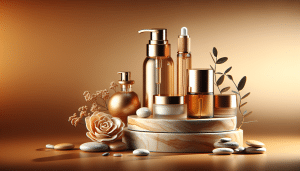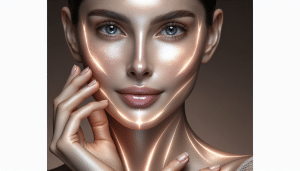Hidden Benefits of Facial Massage You Might Miss
Ella Knight October 26, 2025
Facial massage isn’t just a luxury spa activity—it offers surprising health and wellness benefits that go beyond glowing skin. Discover how simple routines at home can enhance skin texture, relax the mind, and support natural beauty from within.
Why Facial Massage Deserves a Place in Your Routine
Facial massage routines are gaining popularity within wellness communities for good reason. This gentle practice may promote improved circulation, enhanced lymphatic drainage, and relieve facial tension for a holistic boost to well-being. By using techniques with the fingertips or tools like jade rollers, people often notice a revitalized appearance that radiates health. Enhanced blood flow to facial tissues supports oxygen and nutrient delivery, making skin appear brighter and more toned. Importantly, facial massage is easy to incorporate into a daily self-care ritual, fitting seamlessly alongside classic skincare.
The process doesn’t have to be complicated—simple upward strokes and circular movements can be enough to stimulate the skin and underlying muscles. Even short sessions of two to five minutes, when done consistently, can yield noticeable results over time. Beyond the visible changes, the experience itself can be meditative. Many enthusiasts link regular facial massage to reduced feelings of stress and an overall sense of relaxation. Integrating mindfulness or breathwork into the session can deepen its calming effects.
An often-overlooked benefit is the encouragement of product absorption. When moisturizers or serums are massaged into the skin, their active ingredients may penetrate more deeply, maximizing their efficacy. This can make skincare routines more effective without adding more products. Since facial massage is gentle and non-invasive, it’s accessible to nearly everyone and requires minimal investment in tools or time. For those seeking radiant skin naturally, this practice is an approachable addition to everyday life.
Science Behind Skin Glow: How Facial Massage Works
Understanding what happens beneath the skin reveals why facial massage is so effective. When gentle pressure is applied, blood vessels dilate and support healthier circulation under the surface. This vascular boost can make the complexion look more vibrant and less dull. Improved flow also means toxins and metabolic waste can be carried away more efficiently. Some people report a decrease in puffiness and dark under-eye circles—both linked to sluggish circulation and fluid retention.
Lymphatic drainage techniques are frequently used within advanced facial massage to stimulate the movement of lymph fluid. This network helps rid the body of toxins and supports immune function. Even without specialized training, mindful, light strokes along facial contours often promote lymph flow enough to notice a difference in skin tone and texture. For those who experience occasional swelling due to sleep or diet, facial massage can be especially rejuvenating when practiced in the morning.
Another critical effect is muscle relaxation. Over time, facial muscles can become tense, sometimes from habitual expressions or stress. Massage encourages these muscles to soften, reducing the appearance of lines and imparting a more relaxed look. This relaxation cascades into the nervous system, creating a calming influence on mood. When practiced in a quiet space, this technique can bridge the gap between beauty and overall wellness, offering benefits that impact both appearance and mental clarity.
Choosing the Right Technique for Your Skin Goals
There are several facial massage techniques, each offering distinct benefits for varying skin types and wellness needs. Classic Swedish-style massage uses gentle effleurage, or gliding movements, to relax and energize. For deep tissue relief, knuckle or fingertip kneading techniques can target areas of tension, especially along the jawline and temples. Those interested in anti-aging effects often explore acupressure, where gentle, sustained pressure on specific points may promote firmness and elasticity.
For those concerned with sensitive or reactive skin, the key is choosing light, soothing strokes and always using a favorite facial oil or serum as a barrier. Avoid pulling or excessive stretching, focusing on movements that support hydration and comfort. People have experimented with cooling crystals, gua sha stones, and sonic vibration tools as well. Although modern tools can enhance the ritual, foundational techniques using clean hands remain effective and accessible.
Regularity is central to seeing results. Experts suggest two or three short sessions each week is sufficient, although some enjoy the ritual daily. The act of massage can reinforce positive skincare habits and amplify the benefits of other products. As with any new routine, it helps to start gently, observe the skin’s response, and adjust as needed. Over time, facial massage becomes intuitive—tailored to unique concerns and lifestyle rhythms.
Integrating Natural Oils and Products in Facial Massage
Choosing the right product can turn a simple massage into a luxurious skincare experience. Many prefer natural oils like jojoba, rosehip, or sweet almond for their nourishing properties and smooth slip, reducing friction during massage. These oils are packed with essential fatty acids and vitamins that support the skin’s barrier and hydration. For individuals with acne-prone or oily skin, non-comedogenic options such as squalane may be ideal, helping prevent clogged pores.
Adding a facial oil also helps minimize the risk of microtears from dry massage. For extra nourishment, some select serums featuring antioxidants such as vitamin C or E—ingredients known to support skin resilience and brightness. Integrating massage as the application step for such serums can enhance both the efficacy of the products and the soothing sensations of the practice.
Proper cleanup matters, especially for sensitive skin. After massaging with products, it’s often beneficial to use a warm, damp cloth to gently remove excess oil and reduce buildup. For those using adaptogenic or herbal blends, patch testing on a small area ensures compatibility. By customizing massage products based on seasonal skin changes or personal preference, the experience stays fresh and rewarding while boosting the benefits for wellness and beauty alike.
Exploring Mental Wellness and Stress Reduction Through Touch
The connection between touch and emotional health is powerful. Facial massage creates a gentle, mindful pause in the day that allows the mind to slow down and reset. Research links regular touch—whether self-applied or professional—to lower cortisol levels and improved mood. A soft facial massage routine, especially paired with deep breathing, can nurture a sense of calm and equilibrium during busy periods.
This self-care moment is more than skin deep. The repetitive, rhythmic strokes of massage promote relaxation by activating the parasympathetic nervous system, sometimes called the “rest and digest” mode. By focusing on each stroke, sensations on the skin, and the subtle warmth generated, practitioners find a meditative quality in the act. This can be a practical approach to managing daily stress, supporting restful sleep, and encouraging a positive outlook.
Families and partners may also share the practice, enhancing feelings of connection and care. For individuals hesitant to explore full body massage or touch therapies, facial massage often feels approachable and safe. The habit of attending to one’s own wellness for even a few minutes daily becomes an anchor for holistic self-care. In the long run, nurturing mental wellness may reflect outward in both skin quality and a resilient sense of well-being.
Addressing Common Concerns and Myths About Facial Massage
Despite its accessibility, facial massage is sometimes misunderstood. Some worry it could lead to sagging skin or irritation. The evidence suggests gentle, upward strokes used with appropriate lubrication are not harmful and may actually improve skin texture and firmness. For those with particular skin conditions, like rosacea or eczema, consulting a dermatologist prior to beginning a new routine is wise. Staying aware of one’s own skin response is always best practice.
Another common myth is that only professionals can deliver effective facial massage. While spas certainly offer elevated experiences, practicing at home with simple guidance and clean hands can yield meaningful results. Resources like step-by-step video tutorials and science-backed guides from health organizations are widely available, empowering anyone to safely learn and experience the benefits.
Lastly, some believe that facial massage is only suitable for mature or aging skin. In truth, people of all ages can enjoy its benefits, from improved hydration and tension relief to brighter complexions. With gentle techniques and the use of skin-friendly products, the world of facial massage is an open invitation to explore holistic beauty and daily self-care for everyone.
References
1. American Academy of Dermatology Association. (n.d.). Face Massage: Can it Improve Your Skin? Retrieved from https://www.aad.org/public/everyday-care/skin-care-basics/care/face-massage
2. National Institutes of Health. (2018). Effects of Facial Massage on Skin Blood Flow and Relaxation. Retrieved from https://www.ncbi.nlm.nih.gov/pmc/articles/PMC6098734/
3. Cleveland Clinic. (n.d.). Should You Try Lymphatic Drainage? Retrieved from https://health.clevelandclinic.org/lymphatic-drainage-massage
4. University of California, Berkeley. (2013). The Importance of Touch in Human Development. Retrieved from https://greatergood.berkeley.edu/article/item/hands_on_research
5. Mayo Clinic. (n.d.). Stress Management: Massage Therapy. Retrieved from https://www.mayoclinic.org/healthy-lifestyle/stress-management/in-depth/massage/art-20045743
6. Harvard Health Publishing. (2020). Skin Care: Tips for Healthy, Radiant Skin. Retrieved from https://www.health.harvard.edu/staying-healthy/skin-care-tips-for-healthy-radiant-skin







